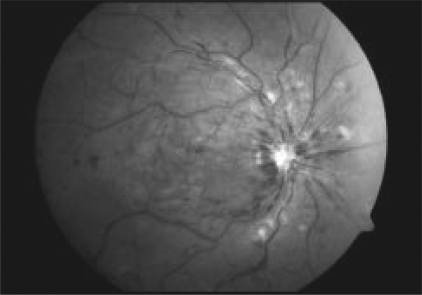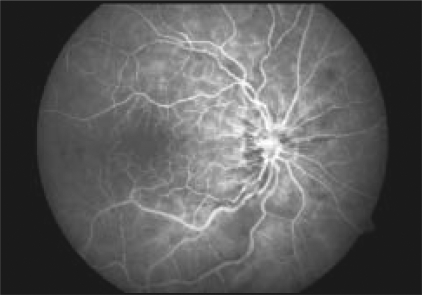Abstract
We report a case of central retinal vein occlusion (CRVO) following Sirsasana, a head-down postural yoga. A 55-year-old male patient presented to us, with sudden-onset loss of vision following Sirsasana, in the right eye. The patient had suffered from pulmonary thromboembolism 5 years earlier and was receiving warfarin prophylaxis. Over 6 months of follow-up, the patient developed neovascularization of the iris and was subjected to panretinal laser with no improvement in visual acuity. Sirsasana could be an important risk factor for CRVO especially in predisposed patients.
Keywords: Central retinal vein occlusion, Sirsasana, Warfarin
Sirsasana is a type of postural yoga asana (or posture) in which the body is completely inverted (headstand), and held upright supported by the forearms, while the crown of the head rests lightly on the floor. The practice of Sirsasana is postulated to increase blood flow to the brain, improving memory and other intellectual functions.[1]
We report a case of central retinal vein occlusion (CRVO) following Sirsasana. Although, its effect on intraocular pressure (IOP) has been studied,[2] there is no study reporting occurrence of CRVO following Sirsasana.
Case Report
A 55-year-old male patient developed sudden loss of vision in the right eye following Sirsasana with wall support (2 minutes) without supervision. The patient had suffered from pulmonary thromboembolism 5 years back and was receiving warfarin prophylaxis. Patient was practicing yoga since past 2 years for 45 minutes, 3–4 times/week. On examination, best-corrected visual acuity (BCVA) was finger counting 1 m in the right and 20/20 in the left eye. Intraocular pressure (IOP) was 12 mmHg in either eye. Fundus examination showed disc edema, scattered superficial hemorrhages, and superficial whitening in macular area in the right eye [Fig. 1], whereas the left eye fundus was unremarkable. Fundus fluorescein angiography (FFA) [Fig. 2] confirmed findings of ischemic CRVO with cilioretinal artery occlusion (Red free photos showed retinal whitening along the course of cilioretinal artery in the maculopapillary region and non-filling of the cilioretinal artery in the early phase of angiogram) All systemic investigations (hemoglobin, erythrocyte sedimentation rate, lipid profile, blood sugar, serum homocysteine levels) were normal, and international normalization ratio (INR) was 2.0. Over 6 months follow-up, the patient developed neovascularization of the iris and received pan-retinal laser photocoagulation with no improvement in vision.
Figure 1.
Red-free photograph showing disc edema, scattered superficial hemorrhages and superficial whitening in the macular area in the right eye
Figure 2.
Fundus fluorescein angiography photo: venous phase shows altered vascular caliber, blocked fluorescence at the disc due to hemorrhages, and macular ischemia
Discussion
Sirsasana is a type of headstand postural yoga performed with or without wall support. This is an advanced pose and should be attempted after practicing forward and backward bends (asanas ), under the supervision of a qualified yoga instructor. Our patient attempted Sirsasana with wall support, without supervision, for 2 minutes. He had no previous experience with Sirsasana but was practicing yoga since 2 years.
Sirsasana is known to cause elevation of IOP, which reverts to normal after cessation of the same.[2 ] A sudden variation in IOP has decompression effect on the eye, as after antiglaucoma surgery, causing decompression retinopathy.[3]
The practice of Sirsasana is reported to increase the flow of blood to the brain, improving memory and other intellectual functions.[1] Although, increased sympathetic vasomotor and sudomotor tone is known to occur after Sirsasana,[4] its effect on ocular hemodynamics has not been studied. Bilateral thromobosis of conjunctival varix has been reported following habitual head standing.[5]
Instructors suggest avoiding Sirsasana in patients with hypertension, congestive heart failure, berry aneurysms, and those above 50 years of age.[1,6] However, there is no existing study to support the above.
INR was established by the World Health Organization (WHO) and the International Committee on Thrombosis and Hemostasis for reporting the results of blood coagulation (clotting) tests. A person taking warfarin might optimally maintain a prothrombin time of 2-3 INR. This international standardization permits the patient receiving warfarin to travel and still obtain comparable test results. It is known that patients receiving warfarin prophylaxis may not to be protected against a CRVO, as in our patient (INR-2).[7] Hence, both the above, in a case of pulmonary embolism, would have predisposed our patient to CRVO.
We conclude that predisposed subjects such as those having a previous thromboembolic phenomenon and age above 50 years (as in our patient) can be warned against doing Sirsasana or head down postures in yoga.
Because of the increased popularity of yoga, a long-term study to know its impact on ocular hemodynamics is needed.
References
- 1.Iyengar GS. YOGA: A Gem for women. 2nd ed. Allied Publishers; 1997. Asanas: Inverted; pp. 180–216. [Google Scholar]
- 2.Baskaran M, Raman K, Ramani KK, Roy J, Vijaya L, Badrinath SS. Intraocular pressure changes and ocular biometry during Sirsasana (headstand posture) in yoga practitioners. Ophthalmology. 2006;113:1327–32. doi: 10.1016/j.ophtha.2006.02.063. [DOI] [PubMed] [Google Scholar]
- 3.Karadimas P, Papastathopolos` KI, Bouzos EA. Decompression retinopathy following filtration surgery. Ophthal Surg Lasers. 2002;33:175–6. [PubMed] [Google Scholar]
- 4.Manjunath NK, Telles S. Effects of sirsasana (headstand) practice on autonomic and respiratory variables. Indian J Physiol Pharmacol. 2003;47:34–42. [PubMed] [Google Scholar]
- 5.Margo CE, Rowda J, Barletta J. Bilateral conjunctival varix thromboses associated with habitual head standing. Am J Ophthalmol. 1992;113:726–7. doi: 10.1016/s0002-9394(14)74810-x. [DOI] [PubMed] [Google Scholar]
- 6.Thakur B, Sirsasana . In: Yoga for family: A holistic approach. 1>st ed. Datta N, Koshy D, editors. Roli Books; 2007. pp. 89–91. [Google Scholar]
- 7.Mruthyunjaya P, Wirostko WJ, Chandrashekhar R, Stinnett S, Lai JC, Deramo V, et al. Central Retinal Vein Occlusion in patients treated with long-term warfarin Sodium (Coumadin) for anticoagulation. Retina. 2006;26:285–91. doi: 10.1097/00006982-200603000-00006. [DOI] [PubMed] [Google Scholar]




